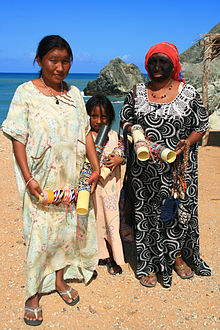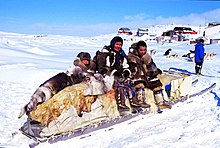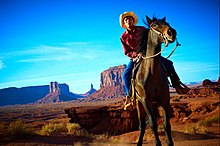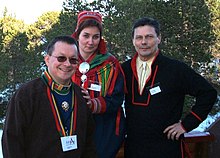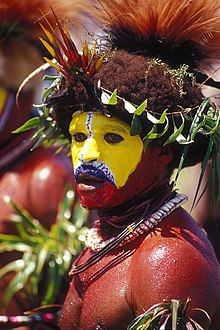Indigenous
In a broad sense, the term indigenous (from the Latin: indigĕna native, from indu- within, and genus born) applies to everything that is related to a native population of the territory they inhabit, whose establishment in it precedes that of other ethnic groups or whose presence is long enough and stable enough to be considered native (that is, originating from a place). With the same meaning, the term native is used more frequently —many times believed to be equivalent—, present in expressions such as "language native”, which is not exactly synonymous with indigenous, since in its correct meaning native means someone born in a territory whether or not their lineage is indigenous to it. It is also common to use terms such as "original peoples", "native nations" or "aboriginals".
In a strict sense and more habitually, the denomination indigenous is applied to the ethnic groups that preserve traditional cultures. With this scope, indigenous groups are called human groups that present characteristics such as:
- To belong to organizational traditions other than the modern state.
- To belong to cultures that survived the planetary expansion of Western civilization.
Indigenous people frequently constitute a minority (although in some cases they are a majority), within national states of a European nature, organized according to cultural, religious, political, economic, racial, etc. guidelines, typical of a largely Europeanized environment. In this way, in the most restricted and used sense of the term, "the indigenous" refers to a pre-European remnant that represents in itself an antithesis of European culture.
Following this usage, it is not uncommon to speak of indigenous peoples in different parts of the world. For example, the Maori are often considered to be an indigenous people of New Zealand. One can also speak of indigenous people in Borneo, in Africa and elsewhere.
However, the native populations of Australia, while also indigenous, are known by the distinctive name of aborigines.
Other peoples who maintain strong cultural patterns prior to the European world expansion, such as the Chinese, Indians, Japanese, Persians, Arabs, Jews, Egyptians, etc. they are not usually included in the term "indigenous" in the strict sense.
In an even more restricted sense, the term "indigenous" is usually applied to American Indians, also called "Amerindians", "Indians", "Native Americans", "original peoples" or "first nations".
Indigenous peoples have organized themselves into movements and associations with the objective of defending and promoting the rights of indigenous people in the world.
Indigenous Rights
The UN system on Indigenous Rights has been developed thanks to the historical social struggles of indigenous peoples from different latitudes of the world. The United Nations attends to Indigenous Rights from the Department of Economic and Social Affairs (DESA), in its Inclusive Social Development Division (UN Indigenous Peoples), as well as by mandate of the Human Rights Council.
The UN system on Indigenous Rights comprises:
- United Nations Permanent Forum on Indigenous Issues.
- Declaration on the Rights of Indigenous Peoples.
- World Conference of Indigenous Peoples.
- The Inter-Agency Support Group (IASG) on Indigenous Issues.
- International Day of the World's Indigenous Peoples.
- UN General Assembly resolutions and discussions on indigenous peoples.
- Indigenous Peoples and the 2030 Agenda.
- Special Rapporteur on the rights of indigenous peoples (UN Human Rights Council resolution 33/12).
- Expert Mechanism on the Rights of Indigenous Peoples.
Convention 169
Convention 169 of the International Labor Organization (ILO) is an international ratification on the recognition of indigenous and tribal peoples in the world. Although there is no specific and exact consideration of indigenous peoples, there can be a general rule on the characteristics of these peoples as established in Article 1 of Convention 169:
- (a) Tribal peoples in independent countries, whose social, cultural and economic conditions distinguish them from other sectors of the national collectivity, and which are governed totally or partially by their own customs or traditions or by special legislation;
- (b) peoples in independent countries, considered indigenous by the fact that they descended from populations living in the country or in a geographical region to which the country belongs at the time of conquest or colonization or the establishment of the current state borders and that, whatever their legal status, they retain all their own social, economic, cultural and political institutions, or part thereof.
- 2. Awareness of their indigenous or tribal identity should be regarded as a fundamental criterion for determining the groups to which the provisions of this Convention apply.
- 3. The use of the term " peoples " in this Convention shall not be construed as implying any involvement in respect of the rights that may be conferred on that term in international law.
Indigenous peoples
By 'indigenous peoples we mean communities of a legal nature that are made up of ethnically identified members (ethnic citizens) and that presumably preserve traditional and aboriginal cultures.
The United Nations Organization estimates the number of indigenous people living in the world at just over 300 million (5,000 peoples settled in 70 countries), of which 50 million reside in the Americas. Other criteria gives a figure of some 350 million indigenous people around the world, in some cases maintaining their ancestral ways of life. Among them, the most outstanding are the nomadic peoples and in general those peoples who live in tribal societies. On many other occasions, indigenous peoples have been forced to assimilate Western life patterns, even though they continue to maintain certain traditions or language.
There are more than five thousand peoples with their own way of seeing the world, their cultural and linguistic particularities and with an increasingly strong will to claim them and feel proud of them, despite centuries of oppression and cultural domination, political, economic and social by stronger socio-economic groups.
American Indians
Indigenous moderns are the descendants of the original population of the continent. Given their enormous diversity, they are often grouped into “families” of peoples, who share a geographic location, some cultural traits, and, in some cases, a common language and history. This is the case of the Andean, Mayan and Caribbean peoples. The percentage of indigenous population varies enormously from one country to another are:
Percentage of indigenous population (2013-2015) which has decreased indigenous peoples over the last 23 years Population
totalPopulation
indigenousVenezuela 31 405 207 725 128 2.30 % Colombia 48 821 405 1 378 884 2.90 % Ecuador 18 000 062 (2022) 1 633 400 (2021) 9.07 % Peru 34 000 970 4 000 000 12 % Argentina 44 494 502 (2018) 1 059 242 (2018) 2.38 % Bolivia 11 383 094 4 553 237 40% Chile 14 619 708 (2002) 692 192 (2002) 4.58 % Nicaragua 5 482 340 805 424 14.0 % Mexico 119 530 753 (est. 2015) 11 900 000 (est. 2014) 10% Guatemala 16 514 591 7 431 565 45 %
Historically, the indigenous peoples of the Americas have been subjected to discrimination and racism (discrimination in language, in labor and salary conditions, sexual discrimination), situations that have been reflected in massacres, in the existence of servile work and many other forms of injustice (especially the permanence of poverty conditions).
Today, the indigenous problem has been taken up again. Numerous indigenous movements and organizations have mobilized to achieve recognition of their cultures, for example intercultural education and the right to land. This is the case of the Zapatista movement and the Zapatista Army of National Liberation (EZLN).
The definition of the indigenous language as a dialect is a prejudice, a form of discrimination that erroneously considers that languages like Nahuatl or Otomi, to give just two of the thousands of examples that exist, are ways of communicating less complex and less developed than Spanish, English or French: the indigenous language is as complex and as rich as any other language in the world. dialect is defined, on the other hand, as any regional (local) variant of the same standard language (whether indigenous or not). For example, Nahuatl, as a standard language, presents many dialectal variants, that is, many dialects: there is Mexican Nahuatl, Guatemalan Nahuatl and, within Mexico itself, there is the Nahuatl of the State of Mexico (Mexiquense), which is spoken in the state of Hidalgo, the one spoken in Puebla, etc. The advent of independence did not help to change this situation; quite the contrary, in many cases it exacerbated it. Another important indigenous language is Quechua, spoken by almost 14 million people in countries like Ecuador, Bolivia, etc.
Indigenous peoples of the Americas (by country)
- Indigenous Peoples of Argentina
- Indigenous Peoples of Belize
- Indigenous Peoples of Brazil
- Indigenous Peoples of Bolivia
- Indigenous Peoples of Canada
- Indigenous Peoples of Chile
- Indigenous Peoples of Colombia
- Indigenous Peoples of Costa Rica
- Indigenous Peoples of Ecuador
- Indigenous Peoples of El Salvador
- Academias de idiomas en Estados Unidos
- Indigenous Peoples of Guatemala
- Indigenous Peoples of Honduras
- Indigenous Peoples of Mexico
- Indigenous Peoples of Nicaragua
- Indigenous Peoples of Panama
- Indigenous Peoples of Paraguay
- Indigenous Peoples of Peru
- Indigenous Peoples of Uruguay
- Indigenous Peoples of Venezuela
The term Indian
Within the general set of indigenous peoples of the world, and in the absence of other specific references, it is understood that the use of the word indigenous refers par excellence to the populations of the Americas that are a continuation of autochthonous peoples that, from Amazonian hunter-gatherer groups to high Andean or Mesoamerican cultures with state organization, were already present on the continent before the European colonization that began on October 12, 1492.
In this usage, the terms Amerindian and, to a lesser extent, indigenous have come to replace the old and ambiguous term indian.
The Europeans called the natives of the islands of the Caribbean Sea Indians because, since the voyages of Christopher Columbus, they believed that he had reached India, in Asia, generating a misunderstanding that lasted over time and, later, would give rise to the American territories being initially known as the Indies by the Spaniards who had recently arrived there. The English called the "West Indies" (West Indies) only to the Caribbean islands that they colonized (not to their colonies on the mainland of the American continent). They had to put "West" to distinguish them from the other colonies they had in the true Asian India and even further east, whose territories they logically named "East Indies" (East Indies). In general, the indigenous inhabitants of the lands to the west of the Atlantic were henceforth known in Spanish as indios, although terms such as "amerindios" or others; and in English the term "indians" it also yields preference to others that are also more euphemistic and less ambiguous, such as "Native American" in the United States of America.
Among numerous native Amerindian movements, the designation indigenous has also lost credibility in favor of self-affirming terms such as original. In this way, many groups that previously identified generically as indigenous now do so as originarios or resorting directly to traditional ethnonyms or in their vernacular languages.
The indigenous movement
Indigenous movements that emerged in the 20th century have given a different meaning to the words indian and indigenous. In the context of these movements, particularly after the Declaration of Barbados I: For the liberation of the indigenous of 1971 and the Declaration of Barbados II of 1977, these ways of calling themselves began to express a political attitude that gives them a more beyond their respective ethnic citizenships (as Indians they conquered us, as Indians we will free ourselves). Even non-American groups also consider themselves indigenous, as in the case of the Lapp groups from northern Europe, who consider themselves included in the idea of nations without territory that prevails in the notion indigenous. Identifying with a name previously considered discriminatory is, as mentioned, a political attitude, an attitude towards power that gives unity to a movement made up of a great diversity of ethnic groups that have demanded from respect for their cultural rights to the political autonomy, passing through a new concept to the dignity of the cultural and ethnic concept of the indigenous in Latin America.
Although in general terms in Europe it is not understood that the oldest European ethnic groups are indigenous, in a strict sense, some European peoples, such as the Lapps, have claimed their indigenous status for themselves, and demanded that the authorities of the nations respect for their rights and autonomy.
In 1969, an article by the writer Normal Lewis denouncing the genocide of indigenous Brazilians led to the creation of Survival International, the main international organization in defense of the rights of indigenous peoples.
Indigenous Asians
The Gaoshan aborigines of Taiwan, the Ainu of Japan and Russia. Another region populated by ancestral peoples of pre-state organization are the mountains north of Indochina in Southeast Asia, currently occupied by Burma, Thailand, Laos, Vietnam and SE China, a multitude of names are used that frequently change from country to country., the following table summarizes some of the denominations:
| Thailand | Laos | Myanmar | Vietnam | China | |
|---|---|---|---|---|---|
| Lahu | Musur | Musur | Muhso | Cosung | Lahu |
| Akha | Ikaw | Kaw | Kaw | Hanhi | Hani |
| Lisu | Lisaw | Lishaw | Lisu | ||
| Hmong | Maew | Maew | Myanung | Hmong | Miao |
| Mien | Yao | Yao | Yaung | Dao | Yao |
Indigenous people of Europe
Although in general terms in Europe it is not understood that the oldest European ethnicities are indigenous of indigenous people, and required to the European nations authorities respect for their rights and autonomy.
The Lapón, Saami or Sami people live in Lapia, a region that extends through northern Norway, Sweden, Finland and the Kola Peninsula, northwest of Russia. There are approximately 80,000 people. There are no official statistics of its population, but they are estimated that about 50,000 live in Norway, 20,000 in Sweden, 10,000 in Finland and approximately 2000 to 3000 in Russia.
Archaeologists have found evidence of the population of the Scandinavian Arctic Coasts for 11,000 years until 6000 years ago for a town that lived from fishing and the hunting of wild reindeer. They have also found ceramics from the ancestors of the lapons dating from 3500 years ago. Lapons are currently considered the aboriginal population of Scandinavia and claim their rights as an indigenous people.
Norway, which houses half of the Sami population, has recognized this population as an indigenous ethnicity according to UN resolutions.
Nenets (survivors of the Samoyedos) and Komis are other indigenous peoples who live near the Ural Montes, are native peoples that have been considered indigenous by the Russian Federation, preserving their language and ancestral customs.
There is currently an increasing influence on the part of the religion of Aseatrú Odinism, which although its current practitioners are not " indigenous people " For the pre-Christian sense, the origin of this religion is native to Nordic Europe. Its growth has been so extensive that Iceland, a country or state of original origin, has included it in its official religions.
There is discussion about whether Basques should be considered as an indigenous people. Some argue that they can be qualified as such, attended that their ethnic origin is different and prior to other closest peoples. Others, on the other hand, do not share this option because, unlike other peoples, several groups and people of Basque origin participated in acts of colonization both inside and outside Europe, although not having participated in its own or other people's colonizations is not usually a conceptual prerequisite to define an indigenous ethnicity.
Indigenous people of Oceania
Many of the Pacific island-based countries were originally populated by Polynesian, Melanesian, and Micronesian peoples and were their sole settlers for several thousand years.
European colonial expansion by overseas empires led to the introduction of new non-indigenous forms of government. During the 20th century, many of the European colonies gained independence at the time of decolonization. However, many of the new states that have arisen in this way continue to be controlled or conditioned by foreign governments and people living outside the Pacific. Some examples of foreign-ruled peoples include the Chamorros of Guam, the Northern Mariana Islands, and the Marshall Islands.
In most of Oceania, unlike in the Americas, indigenous peoples outnumber descendants of settlers (except Australia, New Zealand, and Hawaii). According to the 2001 Australian Census, Aboriginal Australians make up 2.4% of the total population, while in New Zealand 14.6% of the population identifies at least partially as Indigenous Maori.
Indigenous movements
In various parts of the world and especially in America, indigenous peoples have created organizations and carried out actions in order to defend and promote the rights of indigenous peoples, who are usually marginalized and affected by discrimination in modern societies.
Indigenous peoples usually mobilize from their original ethnic groups and the community structures in which they are organized, but they usually establish organizations and interethnic action networks of local, national, subregional, continental and even global scope.
Among the most important indigenous spheres of the indigenous movement, we can mention the Permanent Forum on Indigenous Issues of the United Nations, the successive Summits of Indigenous Peoples of the Americas, the indigenous congresses, etc.
Many countries contain in their constitutions the recognition of the specific rights of indigenous people, usually related to the right to autonomy, land ownership and agrarian reform, discrimination and the protection of indigenous cultures and languages. It is also common to find special laws to guarantee the rights of indigenous people. In some countries (Argentina, Australia, Bolivia, Canada, Chile, Denmark, the United States, Guatemala, Mexico, Nicaragua, New Zealand, Panama, Peru, Venezuela, etc.) there are political institutions designed to guarantee degrees of autonomy for indigenous peoples..
Many of the rights of indigenous people derive from their condition of the fact that they are cultures prior to the constitution of the states in which they live. This question of “pre-existence” has given rise to extremely difficult constitutional and political debates.
Many consider that the discriminatory attitude of indigenous people is a lack of respect, even towards those who today no one would consider indigenous, since indigenous roots are in the origins of most of the inhabitants of these states.
In 1969, an article by the writer Normal Lewis denouncing the genocide of indigenous Brazilians led to the creation of Survival International, the main international organization in defense of the rights of indigenous peoples.
Indigenism
Indigenismo is a cultural, political and anthropological current focused on the study and appreciation of indigenous cultures, and questioning of the mechanisms of discrimination and ethnocentrism to the detriment of indigenous peoples. Indigenismo has its roots in the 'Indian policies' of the viceregal era, when it was considered that this sector should be governed with specific laws linked to their particular beliefs, forms of government, social stratification, etc. It is at the end of the 19th century and the beginning of the 20th, with the vindication of the original cultures by some intellectuals, when institutions and laws began to be created that seek to safeguard indigenous values. However, what began as a cultural movement soon became a political platform that never had indigenous representatives and was absorbed by the plans and promises of the various governments in Latin America.
Indigenous people today
There are many indigenous groups in the Americas, Bolivia being the country with an indigenous population of 60%, where they represent a greater percentage of the indigenous population of Latin America. In Guatemala, for its part, 40% of the population are Mayan indigenous people. In the case of Peru, 33% of the population is indigenous. Indigenous peoples represent around 30% and 12% of the population of Mexico and Chile, respectively, according to estimates from the mid-2010s. In other countries, such as Argentina and Ecuador, 2% and 25% of the population is Amerindian, respectively. In Colombia, the indigenous population is around 3.48%, countries like Venezuela and Paraguay have only around 2% indigenous population, they are minority populations.
In Brazil, the indigenous population is concentrated especially in the remote areas of the west, difficult to access and that from some paradigms are considered underdeveloped, positions that NGOs like Survival International question. These regions are the Amazon, Mato Grosso and neighboring areas, since the coastal territories are totally extinct, either due to miscegenation or other reasons.
In Mexico, the country with the largest native population, the indigenous population is distributed throughout the nation but is especially concentrated in the Sierra Madre del Sur, the Yucatan peninsula and in the most remote and difficult-to-access areas, such as the Sierra Madre Oriental, the Sierra Madre Occidental and neighboring areas, the indigenous population in Mexico is not large due to miscegenation, but the presence of native Mexicans within the national identity is very present due to the high development of Mesoamerican cultures; as is the case in Peru, Bolivia and Guatemala. The state with the largest indigenous population is Oaxaca and the one with the largest indigenous population within its own territory is Yucatán. Ethnic groups such as the Zapotecs, Mayas, Nahuas, Purépechas, Mixtecs, Yaquis, Kikapues and Otomi have managed to improve their living conditions and they have easily adapted to the culture of trade and globalization; Despite the efforts made by different governmental and non-governmental organizations in favor of legal recognition of the culture and quality of life of the original peoples of Mexico, there is still a high degree of marginalization, discrimination, malnutrition and extreme poverty that is leading to the extinction of their culture and serious impacts on their physical and mental health, a situation that extends to many other indigenous and tribal ethnic groups in the world that are imposed a not infrequently criticized model of "progress".
In Peru, the indigenous population is found throughout the country although in minorities, but where it is most focused is in the Andes mountain range (Sierra) and in the Peruvian Amazon (Selva), being the Coast where the majority of the population is mestizo. 38% of the Peruvian population lives in the mountains and only 9.4% in the jungle, while 52.6% of the Peruvian population lives on the coast, being the region with the least indigenous population due to miscegenation.
Uncontacted Indians
It is the name given to indigenous communities in geographic isolation, because they are located in natural areas that are difficult for human access; for example, in the middle of large jungles or forests. There are various uncontacted peoples around the world; mainly in Brazil, Papua New Guinea, Peru, Bolivia, India and equatorial Africa, but some researchers believe that small groups may exist in remote areas not yet explored.
People in these communities live mainly by hunting and gathering. Their natural environment provides them with food, clothing, shelter and entertainment, which is why they do not need to abandon their way of life.
Contrary to the myths that circulate, its inhabitants are not usually aggressive in the presence of foreigners, except for some communities that do choose to keep unknown people away by throwing arrows and/or stones. An example of this occurs on the island of Sentinel del Norte, where its isolated tribe prohibits entry to any foreign individual. The Indian government asks for respect from this community that simply wants to live without disturbances.
Contenido relacionado
Pierre Bourdieu
Applied Linguistics
Biological anthropology
